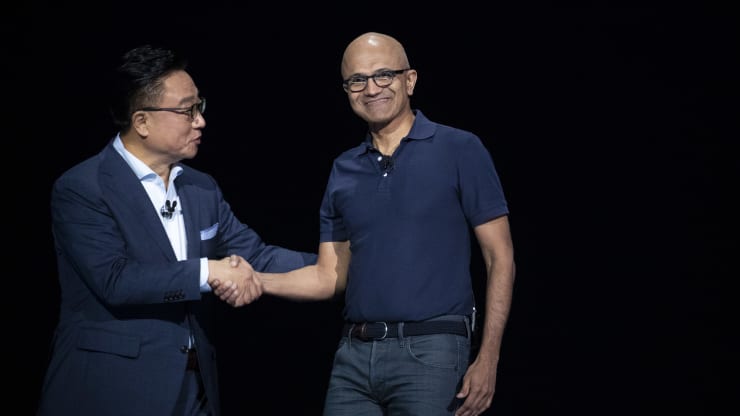Microsoft – Samsung Electronics and Microsoft are bringing back the walkie-talkie. On Sunday, Samsung introduced the Galaxy XCover Pro, a smartphone with a push-to-talk button that initiates a chat using Microsoft’s Teams app. It’s a joint effort by the two tech giants to get their mobile technology in the hands of more workers who spend their days and nights navigating hospital hallways, supermarket aisles and airplane cabins.
Samsung is the No. 2 seller of smartphones in the U.S. behind Apple, which has built its lead with the help of enterprise functionality like security and identity management. Microsoft has largely given up on handsets and ditched its smartphone operating system, but the company still has a big play in mobile through its cloud-based Office 365 suite, which includes Word, Excel, PowerPoint and Teams.
Microsoft set the stage for the Samsung agreement last week in announcing a push-to-talk feature in Teams and said it will be available to a limited set of customers in the first half of the year. The focus is on Android.
At the end of third quarter, Microsoft CEO Satya Nadella said the company had 200 million Office 365 commercial monthly active users. It’s been investing heavily in developing and marketing Teams, which competes with Slack.
Emma Williams, Microsoft’s corporate vice president for Office verticals, said that in adding useful features for Teams, the company is trying to give people a more secure tool for chatting with co-workers than many of the consumer apps that are used in the workplace, whether it’s Facebook’s WhatsApp or Tencent’s WeChat.
Read Also – Mahmood Ahmadu’s Innovate 1 Pay Features On The Front Cover Of The Financial Times
It also cuts down on the number of devices people have to lug around. Williams said that while shopping at a retailer over the holidays, she saw a man carrying a personal phone, a work phone a walkie-talkie and a pager on his belt.
“The product we’re shipping extends the range of traditional walkie-talkie communication,” Williams said in an interview. “It reduces licensing and provisioning costs, and it’s one less device for the employee to carry.”




